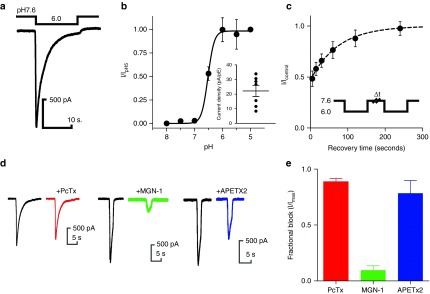Figure 8.

Human pluripotent stem cells (hPSC)-sensory express ASIC1/2 heteromers and ASIC3 homomeric ion channels. (a) Representative trace of an inward current in response to a pH drop from physiological (pH 7.4) to acidic (pH 6.0) conditions. (b) Concentration–response curve for hPSC-sensory expressed ASICs. Similarly to recombinantly expressed ASICs, the Hill slope is very steep (Hill slope = 3.9) with an IC50 = pH 6.5 (n = 7). Inset: non-normalized peak current densities observed at pH 6.0 (22.2 ± 1.7 pA/pF, n = 7). (c) IpH recovery from desensitization was measured by two pH 6.0 drops separated by a test recovery period. Currents were fully recovered with a recovery period between 120 and 240 seconds (τrecovery = 111.1 ± 19.8 seconds). (d) Representative traces to pH6 before (black traces) and after subunit-selective blockers psalmotoxin (ASIC1a left panel), mambalgin-1 (ASIC1a/b 2a/b middle panel), APETx2 (ASIC3 right panel). (e) Quantification of toxin inhibition as shown in d. Psalmotoxin exhibited limited to no inhibition of IpH in hPSC-sensory (0.9 ± 0.01 fraction of control, n = 11), whereas mambalgin-1 showed large inhibition demonstrating the presence of heteromeric ASICs (0.1 ± 0.01 fraction of control, n = 4). APETx2 showed small block (0.8 ± 0.1 fraction of control, n = 4) suggesting low levels of ASIC3 homomers.
